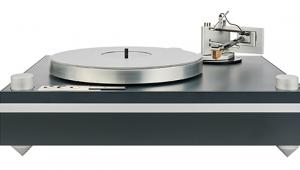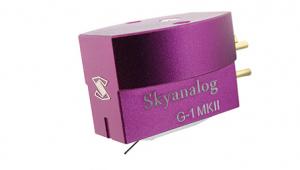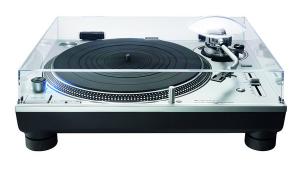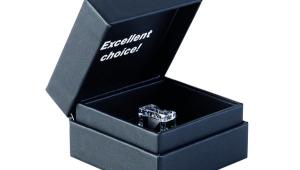Vpi Classic 1 (£2695)
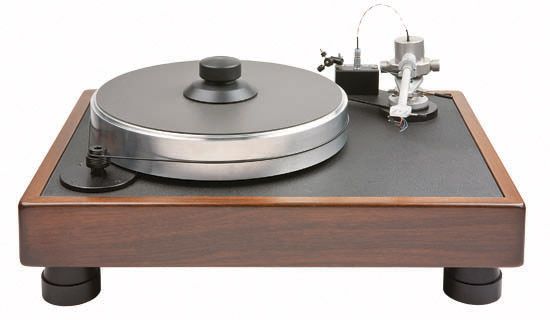
Is it because retro is cool? Perhaps it’s the appeal of its almost plug ’n’ play simplicity… Whatever the reason (and I suspect it’s a combination of many factors, not least the ability for vinyl enthusiasts all over the world to communicate in internet forums) it’s a fact that lovers of the black stuff seem mostly to love this big, bold and brutish turntable, one that’s undeniably a throwback to the good old days when proper turntables were: well, big, bold and brutish.
If you look back to our Nov ’09 issue, where we reviewed VPI Industries’ venerable Aries Scout turntable (updated to MkII status with improved tonearm and 35mm-thick acrylic platter), you will surely agree that it looks sleek and modern – very much a deck of the 21st century, one with its motor separated from the main chassis to minimise breakthrough of deleterious vibrations to platter and tonearm. The latest Classic series of turntables, however, of which this Classic 1 is the entry model, couldn’t be more different.
THIRTY YEARS ON
Thirty years have passed since founder Harry Weisfeld launched his first record player (the company started in 1978 by making record cleaning machines, and there are now three current versions) and consequently the Classics are being marketed to celebrate this anniversary of turntable production.
But while they might look like clones of VPI’s HW-19 design of yesteryear, with an outer wooden frame enclosing the deck’s inner workings, to some extent the Classics fly in the face of everything that Weisfeld has designed before. The HW-19 was a suspended subchassis design. These new Classics are solid. And where for many years VPI has produced decks with outboard motor assemblies (such as the Aries Scout, and the Scoutmaster too), the AC synchronous motor here is in-board, pressure-fitted from below and fixed to a sturdy piece of steel separated from the deck’s top plate by rubber damping. What this affords, of course, is utter simplicity of set-up for the purchaser.
The Classic’s top plate is a sandwich of medium density fibreboard and 11-gauge steel, bonded with long bolts and adhesive. With a 19mm thick frame of oiled walnut, or black-stained oak, to form the plinth, the whole feels immensely sturdy and looks handsome too. The 8kg aluminium platter that sits on an inverted bearing is driven around its periphery via a round-profile rubber belt from a stepped motor pulley. Speed change from 33.3 to 45rpm is manual and a push-button on/off switch is rebated into the left side of the plinth, towards the front. (At £1175, VPI’s SDS electronic speed controller is a rather costly upgrade option since it necessitates changing the motor.) Substantial feet formed of Delrin and steel are threaded to allow levelling, and these provide a degree of vibration isolation, thanks to compliant rubber mountings.
EXTRAS AND FREEBIES
Completing the package is the unipivot arm shown in our photographs (the quoted price is inclusive) – a cost-reduced version of VPI’s JMW 10.5i made specially for this Classic 1 [see Memorial Tonearm boxout]. It is effectively a 10.5in version of the 9in JMW 9 fitted to our Aries Scout II turntable reviewed 18 months ago, featuring an inverted steel cup that sits on an upward-facing (and very sharp) steel pivot point.
Internal wiring of this latest ’10.5i is silver coated copper, the cable exiting at the top of the arm and fitted with a Lemo connector that plugs into a terminal block at the rear of the plinth. Interconnect choice is left to the owner: we used Townshend DCT 300. VPI suggests that twisting the flying leads is all that is really required to provide anti-skating; however, a traditional thread-and-weight bias mechanism is also provided. Either way, you’ll need patience and a test record to set it accurately. And as with pretty much any unipivot, you’ll need a stylus balance to set downforce. In the deck’s packing carton VPI thoughtfully includes a serviceable Shure SFG-2 balance to get you up and running, along with an alignment jig which is similarly easy to use.
The standard JMW 10.5i tonearm alone costs as much as this Classic 1 turntable/arm package, since it features an additional VTA tower for on-the-fly adjustment of vertical tracking angle. If you insist on such luxury, it comes as standard with the considerably more expensive, yet otherwise identical, VPI Classic II turntable.
Classic owners can add a dustcover (£294) and if feeling flush could replace the supplied Delrin record clamp, which screws onto the centre spindle, with VPI’s sexier HR-X centre weight made of aluminium (£148). A further upgrade is VPI’s £588 periphery ring clamp. The UK distributor’s website gives all the details.
VPI supplies both a grey urethane mat and a simple paper mat for the Classic 1’s platter, but in fact suggests using neither. For the record (oops!) I began by trying all three options and soon concluded I concurred with VPI’s recommendation of riding bareback. Harry Weisfeld is quoted as saying that in his system, which is apparently smooth-sounding and does not suffer from any undue brightness, he prefers the enhanced detail and speed that’s delivered when the record is clamped directly to the aluminium platter. And this is precisely what I found in my system.
NIMBLE RUNNER
For the listening tests I fitted an Ortofon Cadenza Blue moving-coil. With Michael Hedges’ Watching My Life Go By [Windham Hill 6.26262] I was struck by the way the Classic resolved the sound of a guitar recorded in a spacious acoustic. The rubber platter mat tended to smooth out the ‘zing’ of the (steel) strings and round off the squeaking of fingers on the fret board. The sound was refined and elegant – spacious, too – but when the vinyl record was mated intimately with the aluminium platter I found the sound even more open and airy, with sharper clarity and focus.
Nor was the subjective improvement simply a gain in HF sparkle and snap. The attack of the guitar, including the leading edges of the notes from the bottom E and A strings, was more clearly defined. And Hedges’ vocal was better delineated, especially during the plaintive ‘Woman of the World’, where his slightly nasal voice is set way back from the plane of one’s loudspeakers in a cavernous acoustic, and where his sometimes lazy diction is difficult to decipher if the presentation is too gentle on the ear.
I did detect a slight ‘romance’ to the sound of Classic 1. As with many (but not all) tube amplifiers there’s a bloom in the bass and softening in the midband that would have lovers of pristine hi-res digital sources, and fast squeaky clean solid-state electronics, saying: ‘You see? Vinyl simply doesn’t sound real!’ Spinning up ‘Gone Buttlefishin’’ from the direct-to-disc recording of James Newton Howard & Friends [Sheffield Lab LAB 23] showed that the turntable doesn’t have quite the control and bass slam of cost-no-object heavyweight decks, the powerful kick drum and resonant crack of the tom-toms sounding a little polite and lacking ultimate precision. However, the Classic does have a nimble, open sound with fine timing that allows the music to flow through, with little compression of dynamics as the music shifts from loud to soft and back again.
Moreover, the Classic 1 is adept at making the most of less-than-perfect recordings, drawing you in to the music where so many high-end sources simply highlight the faults. This touches on a dichotomy in our hobby, of course. Do you want to hear the naked truth, warts ’n’ all, or would you prefer to balance your system so that it makes most of your music collection enjoyable to listen to? In the listenability stakes the Classic 1 is a front runner, not only because it’s kind to ticks and pops but also in the way it unravels complex instrumentation.
FOREVER A MESS
Return to Forever’s 1976 Romantic Warrior LP [CBS 81221] might be considered a pinnacle album of jazz-rock fusion among progressive rock fans, or the epitome of fusion-confusion for those who can’t abide the genre. Whatever, an example of fine high fidelity recording practice it most certainly is not, with a dense and over-complicated production that is all top-and-bottom with little in between. Frankly it’s a mess. Yet even when playing the full on, turbo-charged opening track, ‘Medieval Overture’, the Classic made musical sense of the cacophony. Chick Corea’s electronic keyboards swirled in three dimensions while Stanley Clarke’s nimble bass playing and Lenny White’s utterly manic drums fills remained highly intelligible throughout the roller coaster ride.
‘Rubina’ from Joe Satriani’s debut solo LP Not Of This Earth [Food for Thought Records, GRUB 7] sounded warm, rich and mellifluous, with not a hint of high-frequency glare as the delicate, shimmering percussive effects hovered high in the sound image above the sublime soloing from the guitar maestro. With plenty of low frequency weight underpinning the piece, where Satriani toys with tempo and tone, wailing angrily and then scaling back for some more reflective playing, the VPI proved adept at accentuating the rhythmic pulse and vitality of the music making. Soul-stirring stuff.
Truly great-sounding audiophile albums on vinyl, like Harry James’ Comin’ From A Good Place [Sheffield Lab LAB 6] sounded wonderfully airy and vibrant. The VPI delivered immense scale to the army of brass, the sharp blasting of horns sounding colourful and resonant as they projected beyond the plane of the loudspeakers. Again, the VPI Classic 1 delivered a holographic sound image inviting extended musical exploration, relaxed and free from listener fatigue.
VERDICT
Fitted with a good cartridge this substantial turntable/arm combination delivers a beguiling, three-dimensional sound that should flatter all but the very best cost-no-object systems. There are various upgrade options, but by keeping it simple VPI has produced a lovely record player that offers both a touch of old-fashioned luxury and considerable pride of ownership, at a less than high-end price.
Originally published in the April 2011 issue







